Whether you are new to golf or a long-time veteran of the game, there are probably some things you’ve seen on a golfers scorecard that raise an eyebrow. How about the golf scorecard itself? Slope rating and handicap are things that some golfers who have been in the game for years don’t understand.
I’m going to use a real scorecard from a local course, highlighting different sections as I explain what it means. Giving you all of the details you need to read a golf scorecard. I’ll also share some ideas that you can use to mark your own scorecard to keep track of far more than just your score.
Golf Scorecard Overview
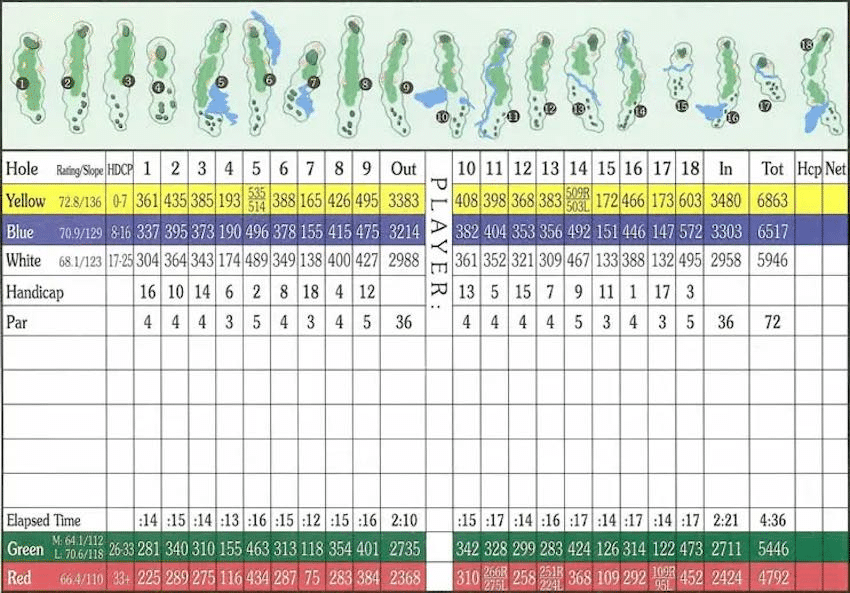
Golf courses each seem to have a slightly different variation for their scorecard, but the important information should always be there, including:
Breakdown of Tees and Yardages for each hole.
Par for each hole
Handicap for each hole
Slope and Course rating
Most golf courses I’ve played also include overviews of each hole, as you can see on the scorecard above.
Tees and Yardages
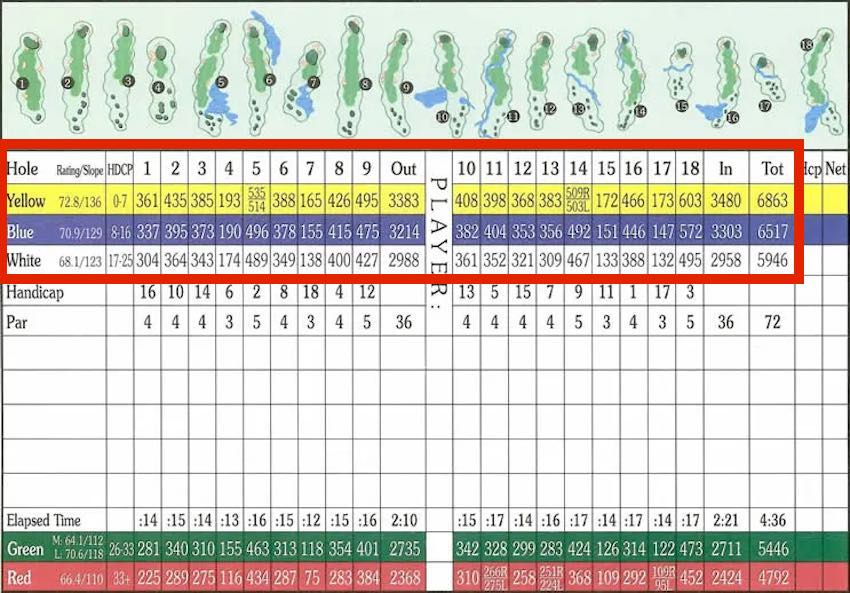
Golf courses typically have at least 3 sets of tees, most golf courses have a few more however. Tees are usually labeled by color. On the scorecard above, you can see this particular golf course has yellow tees, blue tees, white tees, green tees, and red tees.
Some golfers commonly refer to tees by age and/or gender. For example, “men’s tees”, “women’s tees”, “senior tees”. This is a misguided practice. The tee you actually play should correspond to your skill level and the distance you can hit the ball!
For each hole, you will see the total yardage from the tee box to green. Since there are multiple tees, you will see the corresponding yardage from each tee to the green.
Looking at the scorecard above, you can see hole number 1 is 361 yards from the yellow tees. It is 337 yards from the blue tees.
“Playing from the Tips!” – Ever hear someone say this? It simply means they are playing from the longest set of tees on the course.
Par
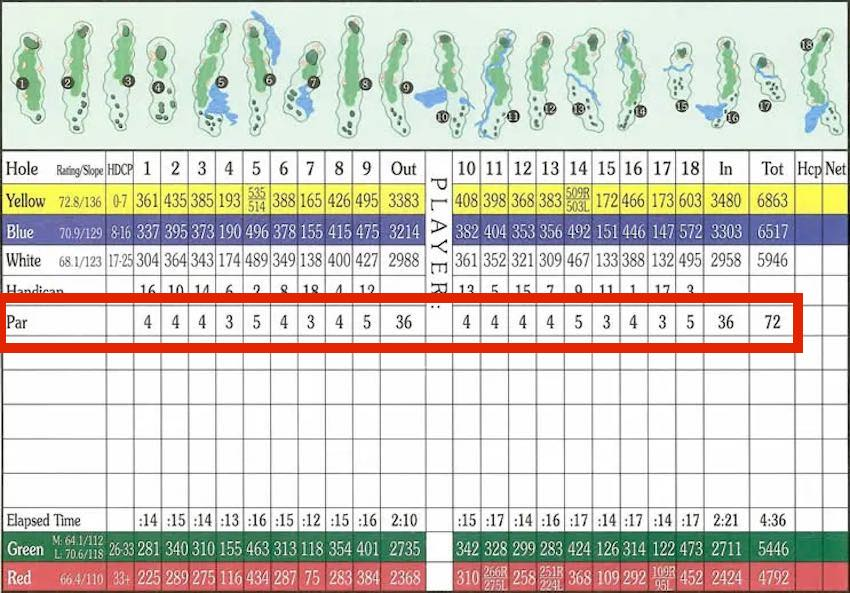
One of the most used sections on any scorecard is the “par” for each hole. Par is the expected number of strokes that it should take a skilled golfer to finish a hole.
Related – Read more about “Par” and other golf terms
You can see on the scorecard above, holes number 1 – 3 are all “par 4’s”, hole number 4 is a “par 3”. You also see the expected total score for the front nine holes is 36, and 36 for the back nine, for a total of 72.
Handicap for each hole
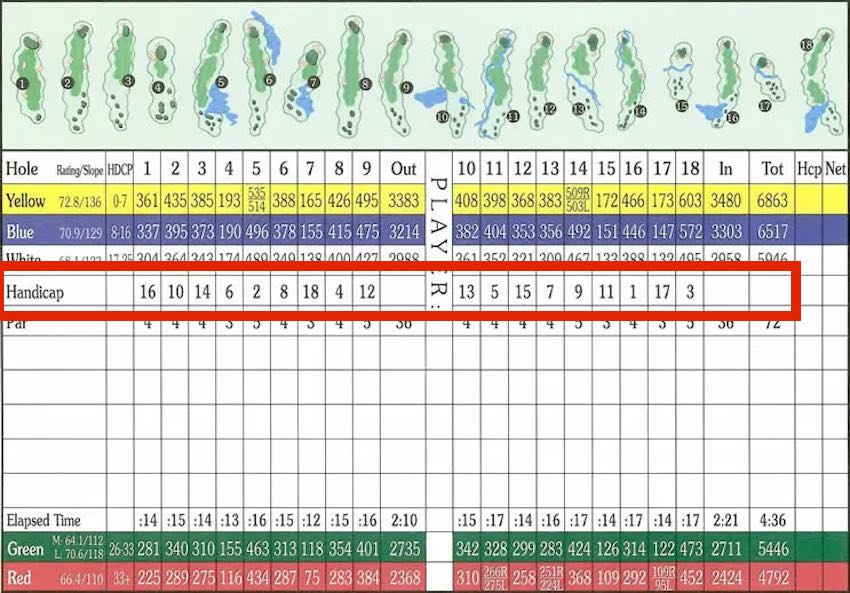
The “handicap” on each hole can be used in two ways.
If you have an established handicap index, this section can be used to calculate your net score per hole.
Handicap can also be used as an indicator of the level of difficulty for each hole.
When you look at the scorecard above, you’ll notice each hole has a “handicap” numbers 1 through 18. 1 is the most difficult hole, while 18 is the easiest. These ratings take into consideration a number of factors including hole distance, obstacles such as water or bunkers, green slope and size, and fairway width.
If you have an established handicap index, for example “4”, your expected score would be bogey on all of the holes with a handicap of 4 or below. So looking at the scorecard above, a player with a 4 handicap would have an expected score of bogey on holes 5, 8, 16 , and 18.
This is particularly useful in a Match Play event.
Related – How to calculate a golfers handicap
Slope Rating & Course Rating
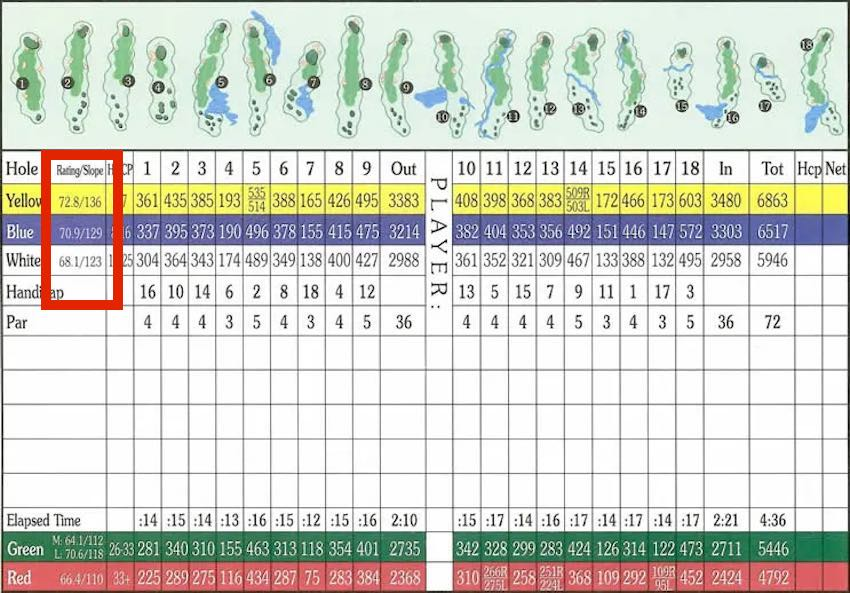
Slope and Course ratings are typically only used by golfers who have an established handicap index, or are working to establish a handicap. These ratings are used in the handicap calculation process.
For golfers who do not have a handicap, this information is only useful in understanding relative difficulty of a golf course.
Course rating is the expected number of strokes a scratch golfer should score on a particular course based on its relative difficulty. You can see from the scorecard above, the course rating is a 72.8 on the yellow tees. This means a scratch golfer would be expected to to average 72.8 on this particular course from the yellow tees.
Slope rating is the relative difficulty of a particular course and is calculated with several factors that include effective playing length, obstacles, topography, trees, rough etc. The slope rating also utilizes the course rating in its calculation.
According to the USGA, “a golf course of standard relative difficulty has a slope rating of 113”. The lowest slope rating is 55 and the highest is 155.
Discover the hardest golf courses in the world that carry a 155 slope rating.
Golf Scorecard Symbols
It is pretty common to see golfers circling or placing a box around their score for a particular hole. This is a helpful way to quickly add your total score when you read a golf scorecard.
You may also see golfers keeping track of things like number of putts, fairways hit, greens in regulation, and even keeping score of your mental game.
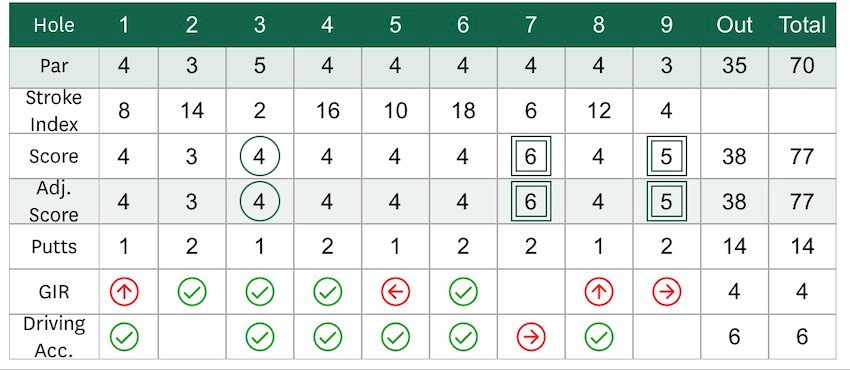
The scorecard above is a snapshot of the front nine from my last round of golf. I use the GHIN Mobile app, but you can easily do the same things with a physical scorecard and a pencil.
You can see on hole number 3, I had a birdie, which is circled. Then on holes 7 and 9, I had double bogey, indicated by the double square.
Eagle = Double Circle
Birdie = Circle
Par = Blank
Bogey = Square
Double Bogey = Double Square
You also see that I am tracking the number of putts on each hole, Greens in Regulation (GIR), and driving accuracy. A checkmark means I hit the fairway, and/or I reached the green in regulation. The red arrows indicate that I missed the fairway, or green, and the direction of the arrow corresponds to where I missed.
There are a couple of blank spaces on the card, that was simply due to me forgetting to track it, or on the par 3’s not keeping track of driver accuracy.
You can also keep track of your mental game for each hole. Specifically – Focus, Confidence, and Response. Check out the full article on keeping a golf mental scorecard!
Good luck on the golf course!
